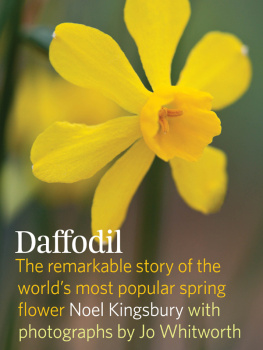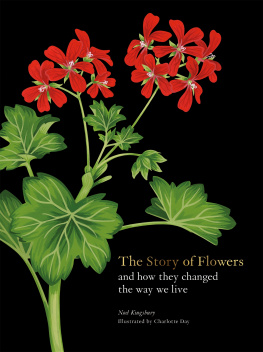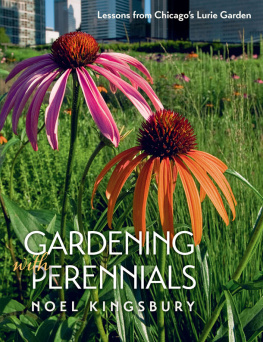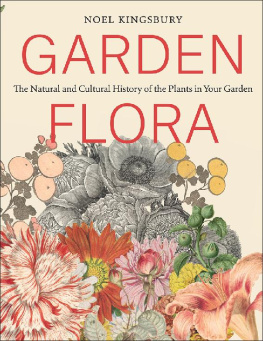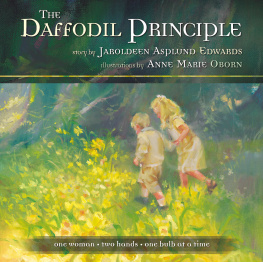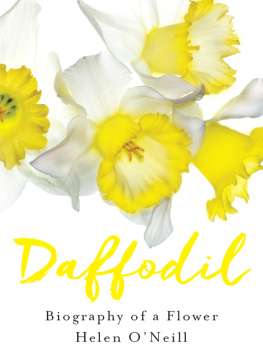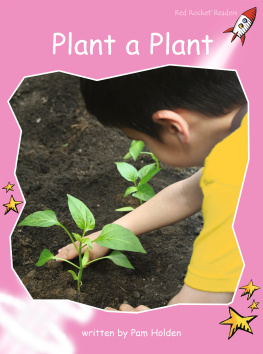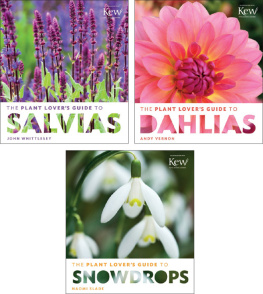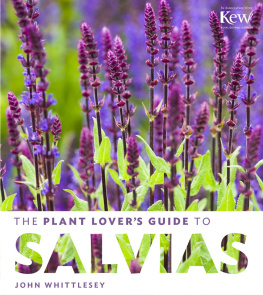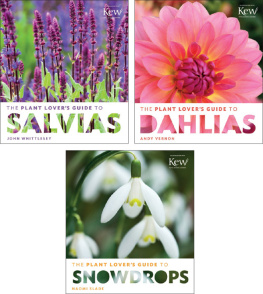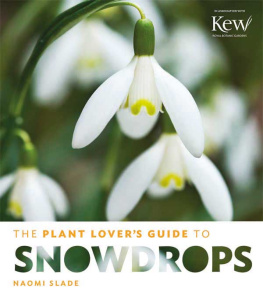
Daffodil

Daffodil
The remarkable story
of the worlds most
popular spring flower
Noel Kingsbury with
photographs by
Jo Whitworth
Timber Press London Portland
Frontispiece: Bunting AGM. Photo by Jo Whitworth.
Copyright 2013 by Noel Kingsbury and Jo Whitworth. All rights reserved.
Published in 2013 by Timber Press, Inc.
The Haseltine Building
133 S.W. Second Avenue, Suite 450
Portland, Oregon 97204-3527
timberpress.com
6a Lonsdale Road
London NW6 6RD
timberpress.co.uk
Printed in China
Book design by Patrick Barber
Library of Congress Cataloging-in-Publication Data
Kingsbury, Noel.
Daffodil: the remarkable story of the worlds most popular spring flower/Noel Kingsbury; with photographs by Jo Whitworth.1st ed.
p. cm.
Includes bibliographical references and index.
ISBN 978-1-60469-318-8
1. Daffodils. 2. DaffodilsHistory. I. Whitworth, Jo. II. Title.
SB413.D12+
A catalog record for this book is also available from the British Library.
Contents
Acknowledgements
THIS BOOK was photographer Jo Whitworths idea (she has a family connection with the Backhouses), but it grew naturally out of my interest in the history of plant breeding, and indeed in daffodils. So first of all I must thank Jo and Rob Whitworth for the idea and their commitment to this project.
Im very grateful to Kate and Duncan Donald for their hospitality when I visited them at Croft 16 in the Scottish Highlands (and in driving me eighty miles to and from the nearest airport) and their help in answering my questions; to Joy Uings, for passing her dissertation on Edward Leeds on to me; to Charles Chesshire, for various insights into the Williams family of Cornwall; to Robert W. Scotland, for sending me a preliminary of his paper on the origin of the daffodil corona; to RHS Daffodil Registrar Sharon McDonald, for answering various questions; to Chris Braithwaite at Acorn Bank, Cumbria; to David Beuch at Cotehele; to John Lanyon, whose previous work at Cotehele was how Jo and I got started on this daffodil enterprise; and to Chris Bligh, who has done so much to promote the conservation of the feral daffodils of Gloucestershires Golden Triangle. Normally, when researching and writing a book like this, the RHS Lindley Library in London would be the first port of call; unfortunately a minor fire (but with much smoke) in August 2011 resulted in its closure for many months. I managed a short visit to the building site, thanks to Barbara Collecott, Liz Gilbert, and other staff. Daffseek.org has been an invaluable source of advice, so thank you to Nancy Tackett and Ben Blake, the website administrators.
I am grateful to the breeders featured in the book who answered my questions and supplied pictures illustrating their work: Ron Scamp, Elise and Richard Havens, Brent and Becky Heath, Bob Spotts, and Harold Koopowitz.
It has been good to work with Timber Press again, and Anna Mumford as commissioning editor should be congratulated on seeing the potential in the concept of this book; thanks also to all the other Timber staff who worked on it. Finally, my wife, Jo Eliot, has been her usual loving and supportive self during my work on the project.
JO WHITWORTH would like to thank the following people and locations for their generous help with the photography for this book: Kate and Duncan Donald at Croft 16 Daffodils, Wester Ross, Scotland; Brodie Castle, Forres, Scotland (National Trust for Scotland); Ron Scamp at Quality Daffodils, Cornwall; Jo Selman, Tamar Valley, Cornwall; New Generation Daffodils, Cornwall; Fentongollan Farm, Cornwall; Broadleigh Gardens, Somerset; Great Dixter, East Sussex; Sutton Court, Hereford; Farndale Nature Reserve, North Yorkshire; Sharon McDonald, RHS International Daffodil Registrar; Chris Bligh, Kempley, Gloucestershire; The Daffodil Society; Woodborough Nursery and Daffodil Pick-Your-Own, Pewsey, Wiltshire; RHS Gardens at Wisley and Rosemoor, and The National Trust. And a special thank you to Rob Whitworth for all his help and advice.
PRELIMINARY NOTES
Three acronyms are used:
RHS = Royal Horticultural Society (of the United Kingdom)
AGM = Award of Garden Merit (given by the RHS)
USDA = United States Department of Agriculture
Often when a daffodil variety is mentioned, its division is given (these are explained in the first chapter), its breeder named (if known), and the date provided for its first flowering (for older varieties) or when it was first registered with the RHS. This information is offered either in accompanying text or, if not, in parentheses after the name.
All months apply to the temperate Northern Hemisphere. Those in the Southern Hemisphere will need to convert months to their opposites.
Daffseek.org is the authority for names.
Calculations for converting historical prices to modern ones were made using this site: measuringworth.com/ukcompare.
INTRODUCTION
Daffodils and their place in our culture

Daffodils are somehow the quintessential spring flower. The appearance of their distinctive yellow blooms is a sure sign that winter has either ended or is about to soon. Unlike the tulip, which appears to be dependent on us for its continued re-emergence in the garden, daffodils reappear faithfully every year; and not just in the garden but in places such as roadsides, churchyards, and parks where they have been planted, often decades agoin some cases over a century ago. These plants are clearly great survivors, thriving even in places where they have obviously been accidentally dropped or discardedthe flowers frequently mark where someone emptied the back of their car of garden waste into a ditch or hedge, little thinking that the event and scene of their crime would be annually and flamboyantly marked for so many years to come.
There are around twenty-seven thousand unique cultivars of daffodil. Unlike other flowersroses, tulips, orchids, whose numbers of deliberately bred varieties range across great swathes of the spectrum or show off an extravagant range of shapesdaffodils are remarkably alike. All single cultivars have the same basic shapea cup (also called a corona) and petals (although botanists do not call them petals); even the doubles or the strange split-corona varieties easily betray their basic inheritance. Above all there is the colour, more or less every shade of yellow which can be imagined, but very little else: white of course, but then almost every flower has at least one white variant, some flashes of orange, but never very much, and thats it; there are so-called pink varieties, but they are more of a tan-apricot. One of the fascinating things about daffodils is just how much play we can have with the same basic design and the same colour scheme, about how much breeders, the bulb trade, and wethe customerskeep on coming back for more, as if we can never leave this most successful design alone.
At the heart of this book is the idea of the daffodil as a metaphor for our relationship with nature, as being a cultivated plant, but one which is capable of also living its own life. Like cats, they feel only partly domesticated. The book is as much about the daffodil as cultural icon as it is about the daffodil as garden plant. Daffodils appear in paintings and in poetry, as emblems of spring and of nature. This cultural status is surely a large part of their appeal; we buy them as tight buds from florists as early as we can at the end of the winter not just because we know they will be pretty and yellow, but because Wordsworth and other poets wrote about them, and they appear endlessly reproduced as a sign of spring at every level of art from the museum-hung masterpiece to souvenir-shop kitsch. The daffodil cut-flower industry is a big one, and historically it was something of a pioneer in the craft and business of how to transfer the golden promise of spring several hundred miles, from the field to the vase on the table. The social history of this industry is part of this book too, as it has been an important driver in directing how daffodils have been bred and appreciated.
Next page
